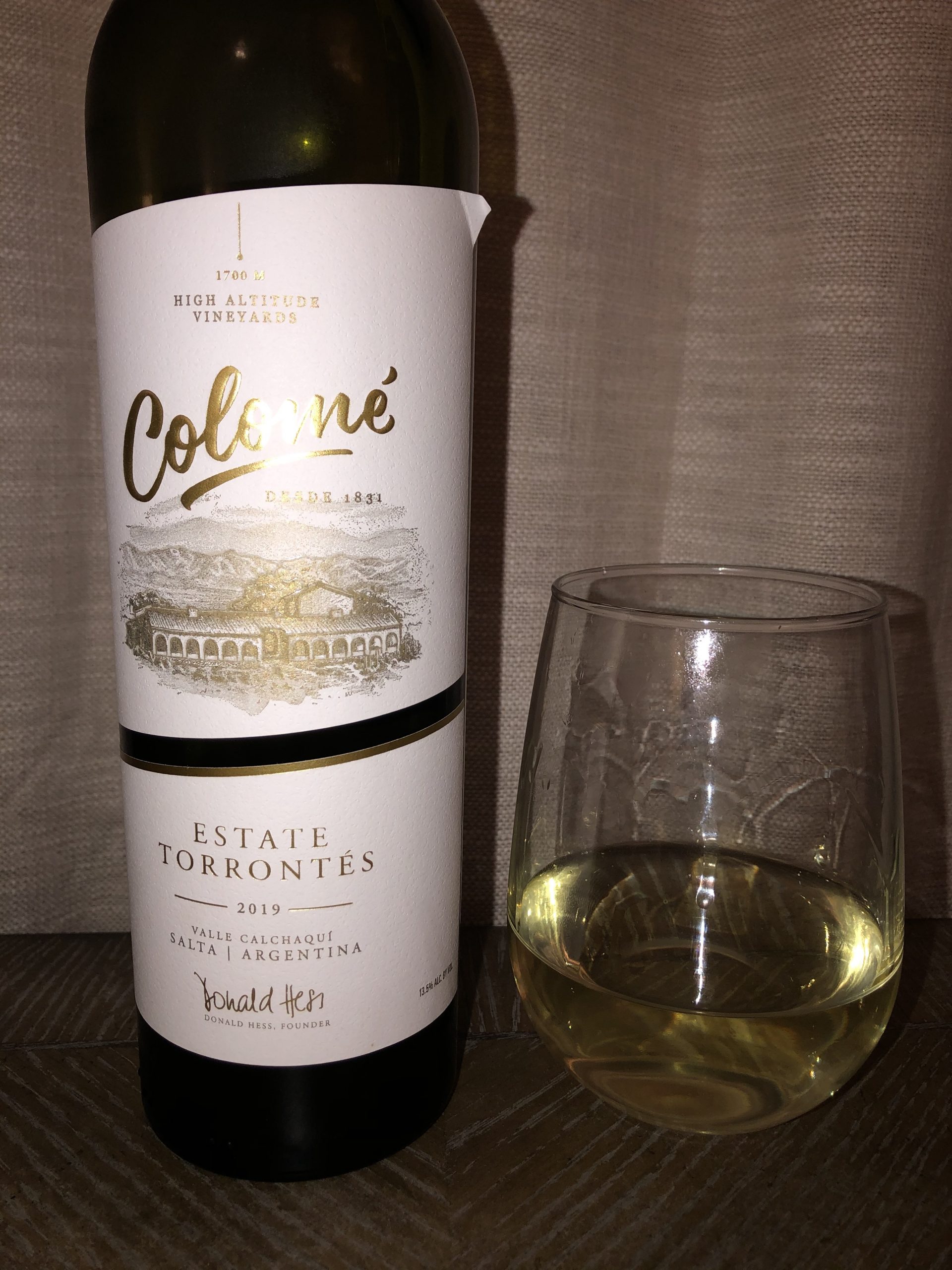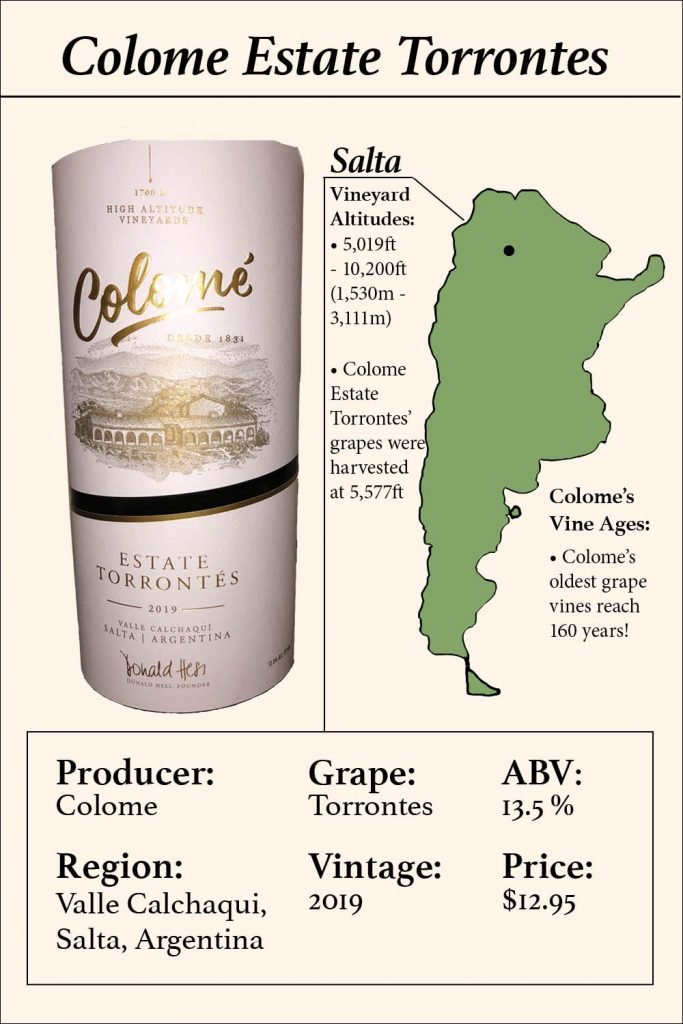Wine Review: Colome Estate Torrontes 2019

Wine Review: Colome Estate Torrontes
Producer: Colome
Region: Valle Calchaqui, Salta, Argentina
Grape: Torrontes
Vintage: 2019
ABV: 13.5 %
Price: $12.95
The Overview:
Bodegas Colome is oftentimes regarded as growing and cultivating at the highest altitude vineyards in the world. While the grapes for this particular bottle are not grown at their highest vineyards (10,207 ft/3,111 m), they are still grown at higher altitudes than most grapes in the world (5,577 ft/1,700 m). Colome’s Estate Torrontes makes for a silky, fuller-bodied white wine with initial aromas and tasting notes of pear and green apple, later opening to refreshing hints of lemon, citrus, and sweet herbal notes such as elderberry.
I am not usually one for white wine, but I am working my way into finding the white wines I do like. I figured this one could not possibly be bad, coming from an esteemed winery in Argentina and the grapes being grown at some of the highest altitudes in the world. While it was not what I was expecting, I still enjoyed this Argentine beauty very much. For white wine drinkers, particularly those that like sauvignon blanc, this is right up your alley. For those that avoid white wine but want to expand your palette and interests, like me, pair this with spicy pad thai and it will do wonders.

The Area:
Salta is one of the most northern regions of Argentina and is home to some of the highest-altitude vineyards in the world, reaching up to a little over 10,000 ft (3,111 m). With these extremely high-altitude vineyards, it makes sense that the area is largely dominated by mountainous terrain. Wineries here, such as Colome, specialize in Torrontes and malbec.
Another interesting aspect of Colome’s Torrontes is that they narrow the bottle’s origins down to Valle Calchaqui, a specific sub-region of Salta’s grape-producing area. Valle Calchaqui covers some of the highest altitudes of the region, starting at 5,019 ft (1,530 m) and ending at 10,200 ft (3,111 m), and then it extends through Catamarca, Tucuman, and Jujuy. These are other grape-producing regions in the north of Argentina. Altogether, these areas only cover a relatively small amount of vineyard acreage and are able to use even less of what is grown. This is due to the extreme altitudes, soils, and climates.

The Grape:
Torrontes as a grape and wine tends to go under the radar in the wine world due to it largely only being produced in its native country, Argentina. Torrontes is a white grape that gives off pear, sweet floral, and lemon aromas and tasting notes. If you find any Torrontes, it is definitely worth checking out due to its low grape yields and production, even if it is not Colome.
The Nose:
Right off the bat, there are strong, but calm and pleasant aromas of pear. As the wine aerates, the pear opens up to green apple with an underlying floral sweetness. The floral sweetness is subtle, but there as it opens up.
The Tongue:
Unlike the aromas, the pear and green apple are there together from the start. The pear is the front runner, while the green apple adds a contrasting semi-sweet sourness. After a few sips and some exposure to the surrounding oxygen, lemon zest and elderberry start to make subtle, yet significant and welcoming appearances. The last tasting note to come around is very mild citrus that goes away as soon as you recognize it.
I have heard people compare Torrontes to a sauvignon blanc, and I found this to be true to some degree. The initial flavors immediately jumped out as a sauvignon blanc, which was slightly off-putting to me. As the air and food combo did its magic, other tasting notes opened up such as lemon, elderberry, and even some citrus. This was a medium-bodied white wine with acidity leaning towards the stronger side. The overall mouthfeel differed from a sauvignon blanc and what I would expect with white wines in general. This Argentine wine had a full silkiness that provided a nice and interesting texture.
Final Notes:
Again, if you find a Torrontes, especially a Colome Torrontes, buy and try it. Whether you like white wine or not, this particular grape and bottle is such an interesting and less common wine to find. It is not necessarily rare or impossible to find, but if your local store carries any Torrontes, the selection will likely be small. Being someone that does not usually care for white wine, I was pleasantly surprised and mainly bought the bottle due to the extremely high altitudes and my love for Argentine wine. It is a great way to begin to explore Argentina’s lesser-known wine region, Salta, and a refreshing break from Argentine malbec.
With notes of pear, green apple, lemon, citrus, and sweeter floral notes, this makes for a beautiful, diverse wine with a well-rounded, medium body. People also tend to get notes of peaches, honey, minerals, and other refreshing fruits, and I hope to pick up on some of those the next go around. Torrontes generally pairs well with spicy, acidic food such as Asian and Indian food. Colome’s Torrontes was no exception as I drank it with my Thai-hot pad Thai.
